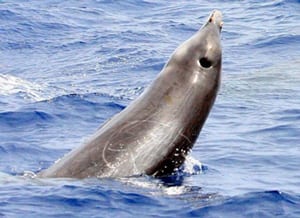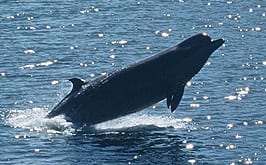Ziphiidae
Cetacean Family
- Ziphiidae
Species within this Family
- Berardius arnuxii – Arnoux’s Beaked Whale
- Berardius bairdii – Baird’s Beaked Whale
- Hyperoodon ampullatus – Northern Bottlenose Whale
- Hyperoodon planifrons – Southern Bottlenose Whale
- Indopacetus pacificus – Longman’s Beaked Whale
- Mesoplodon bidens – Sowerby’s Beaked Whale
- Mesoplodon bowdoini – Andrews’ Beaked Whale
- Mesoplodon carlhubbsi – Hubbs’ Beaked Whale
- Mesoplodon densirostris – Blainville’s Beaked Whale
- Mesoplodon europaeus – Gervais’ Beaked Whale
- Mesoplodon ginkgodens – Ginkgo-toothed Beaked Whale
- Mesoplodon grayi – Gray’s Beaked Whale
- Mesoplodon hectori – Hector’s Beaked Whale
- Mesoplodon hotaula – Deranigayala’s Beaked Whale
- Mesoplodon layardii – Strap-toothed Whale
- Mesoplodon mirus – True’s Beaked Whale
- Mesoplodon perrini – Perrin’s Beaked Whale
- Mesoplodon peruvianus – Pygmy Beaked Whale
- Mesoplodon stejnegeri – Stejneger’s Beaked Whale
- Mesoplodon traversii – Spade-toothed whale
- Tasmacetus shepherdi – Shepherd’s Beaked Whale
- Ziphius cavirostris – Cuvier’s Beaked Whale

Gervais’ Beaked Whale
Defining Characteristics
- Beaked whales are generally suction feeders that feed mostly on squid and deep water fishes that are normally found at depths of between 650 ft (200m) and 6500 ft (2000m), and generally close to the bed.
- Males reach a maximum length of about 30 feet (9 meters) while the females grow only about 25 feet (7.5 meters).
- Males usually develop a large bulging forehead; on the other hand the female’s forehead is much smoother.
- Both sexes have a short snout or beak that ranges in colors from dark brown on the back to pale yellow on the belly. Mature males usually have a white or light patch on their forehead.
- Males also have one pair of small teeth in their lower jaw, and female’s teeth never break through the skin.
Interesting Facts
- Cuvier’s beaked whale is the deepest diving of all cetaceans. Data from a satellite tag recorded a dive of 9,816 feet (2992m) that lasted 97 minutes.
- The Baird’s beaked whale is the biggest beaked whale and second largest odontocete. It can reach lengths of 40 feet (12+m) and weigh 20,000 lbs (9072 kg).
- Studies have been done confirming that the beaked whales are deep divers; they descend to depths between 800 and 1500m. They can stay submerged for over an hour.
- Females reproduce when they are about seven to ten years old. They stay pregnant for 12 months, and usually have their calves in the spring or early summer. It stays with its young for at least one year.
- They all communicate through echolocation.
- They are very social; they form in large groups with highly synchronized behavior
- Groups range from four to ten individuals.
Habitat Range
- Are found in all oceans except under the permanent ice pack at either pole.
Threats to Survival
- Since they live in the open ocean, entanglement in drift nets could become a threat to beaked whales.
- Beaked whales are disturbed by Sonar testing because their hearing is so sensitive. The whales usually fall silent and move away from the loud noise. The use of sonar by the navy has been linked to beaked whales becoming stranded.
Life Expectancy
- They are thought to live for thirty or forty years.

Northern Bottlenose Whale. Photo by Pádraig Whooley
References
- http://animals.jrank.org/pages/3160/Beaked-Whales-Ziphiidae.html
- www.beakedwhaleresource.com
- Carwardine, Mark. Whales Dolphins and Porpoises. London: Dorling Kindersley Publishing, Inc., 1995. Print
- http://encyclopedia.mitrasites.com/imgs/gervais’-beaked-whale.html
- http://www.iwdg.ie/conservation/?speciesid=2215
Researched and written by Raven Medeiros-Neves, NBWM Apprentice, March 2012
Last modified: June 7, 2018


